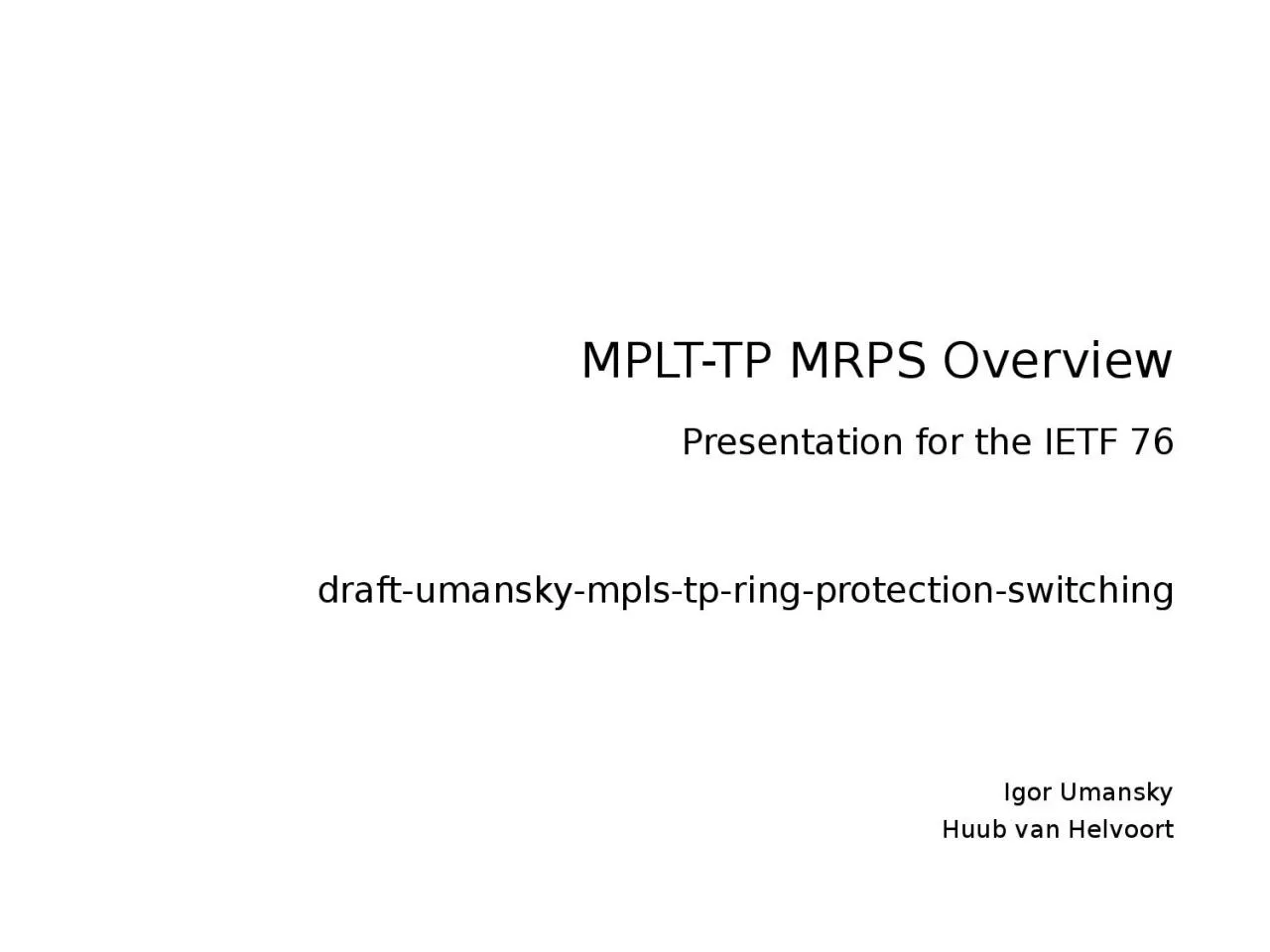

draftumanskymplstpringprotectionswitching Igor Umansky Huub van Helvoort 2 Introduction MPLSTP Ring Protection Switching MRPS is a mechanism addressing the requirements for protection of the MPLSTP LSPs in a ring topology ID: 1033256
Download Presentation The PPT/PDF document "MPLT-TP MRPS Overview Presentation for t..." is the property of its rightful owner. Permission is granted to download and print the materials on this web site for personal, non-commercial use only, and to display it on your personal computer provided you do not modify the materials and that you retain all copyright notices contained in the materials. By downloading content from our website, you accept the terms of this agreement.
1. MPLT-TP MRPS OverviewPresentation for the IETF 76draft-umansky-mpls-tp-ring-protection-switchingIgor UmanskyHuub van Helvoort
2. 2IntroductionMPLS-TP Ring Protection Switching (MRPS) is a mechanism addressing the requirements for protection of the MPLS-TP LSPs in a ring topology.Specifically this mechanism is designed to satisfy the optimization criteria considered in ring topologies (see “MPLS-TP Requirements”).The MRPS mechanism is designed to support point-to-point as well as point-to-multipoint LSPs.The MPLS-TP section layer OAM is used to monitor the connectivity between each two adjacent nodes.The Automatic Protection Switching (APS) protocol is used for coordination of protection switching actions between the ring nodes.
3. 3Protection ringThe protection ring consists of two counter-rotating rings, transmitting in opposite directions relative to each other. Both rings carry working and protection traffic.The bandwidth on each ring is divided so that a part of ring capacity is dedicated for the working traffic and another part is dedicated to the protection traffic. The protection bandwidth on one ring is used to transport the working traffic from the other ring in case of failure.Part of ring bandwidth can also be dedicated to carry unprotected non-preemptable traffic (NUT).
4. 4Architecture types – WrappingWrapping:The Wrapping technique implies that the node detecting a failure sends out an APS request to the (opposite to the failure) node adjacent to the failure. The APS request is transmitted over the APS communication protocol.When a node detects a failure or receives an APS request through APS protocol addressed to this node, the traffic of all working LSPs/tunnels transmitted towards the failed span is switched to the protection LSPs/tunnels in the opposite direction (away from the failure). This traffic travels around the ring to the other node (adjacent to the failure) where it is switched back onto the working LSPs/tunnels.The nodes that performed the protection switching revert back to the normal traffic flow when the failure or APS request is cleared.
5. 5Wrapping example – point-to-point
6. 6Wrapping example – point-to-multipointBandwidth dedicated for working trafficNode ANode BNode CNode DNode ENode Fa) Normal stateb) Failed stateLSP QNode ANode BNode CNode DNode ENode FBandwidth dedicated for protection traffic
7. 7Architecture types – SteeringThe Steering technique implies that the node detecting a failure sends an APS request to the node adjacent to the failure (away from the failure).The APS request is processed by all intermediate nodes in the ring. For each affected LSP the source node (that adds traffic onto the ring) and the sink node (that drops the traffic from the ring) switches the traffic from working LSPs/tunnels to the protection LSPs/tunnels and restore normal traffic flow when the failure or APS request is cleared.Te example of the steering technique is shown on the next slide.
8. 8Steering example
9. 9APS protocol operation basicsThe MPLS-TP MRPS protection operation is controlled with the help of the MPLS-TP Section OAM APS protocol.The APS protocol carries the APS requests, both automatic and externally generated commands, between the ring nodes.The protocol type is a 1-phase protocol with support of acknowledgement mechanism by means of Reverse Request code.
10. 10APS protocol operation basics (cont.)Each node on the ring is identified uniquely by assigning it a node ID used for detection of the messages addressed to it.When no protection switches are active on the ring, each node dispatches periodically APS PDUs to the two adjacent nodes, indicating no switch request.When a node determines that a protection switching is required, it sends the appropriate bridge requests in both directions.‘Destination node’ is a node that is adjacent to a node that identified a failed span.When a node that is not the destination node receives a bridge request and it has no higher priority local request it transfers the APS information as received. In this way, the switching nodes can maintain direct APS protocol communication on the ring.
11. 11Protection switching triggersProtection switching actions (bridge requests) are conducted when:they are initiated by operator control (e.g., manual switch, forced switch, and lockout of protection) without a higher priority switch request being in effect on addressed span or entire ringan MPLS-TP Section SF is declared on the associated span and without a higher priority switch request (e.g., lockout of protection, forced switch) being in effect on addressed span or entire ring and the hold-off timer has expiredthe wait to restore timer expiresAPS controllerDetected failuresExternally initiated commandsIncoming protocol messagesUpdated protocol messagesProtection switching operation
12. 12Manual controlThe following commands are not transferred by the APS PDU:ClearLockout of workingThe following commands (bridge requests) are transferred by the APS PDU:Lockout of ProtectionForced Switch to protectionManual Switch to protectionExercise
13. 13Automatically initiated commands The node initiates the following bridge requests automatically:Signal FailWait-To-RestoreReverse Request
14. 14APS payload fieldsDestination Node ID: The destination node ID is set to the value of the node ID for which the APS request is destined. The destination node ID is always that of an adjacent node.Source node ID: The source node ID is set to the value of the node ID of the node generating the APS request.Bridge Request code: A code consisting of four bits carrying the bridge request message from a tail-end node to the head-end node requesting the head-end to perform a bridge of the normal traffic signals.
15. 15Next stepsFinalise descriptions.Request to become WG draft.